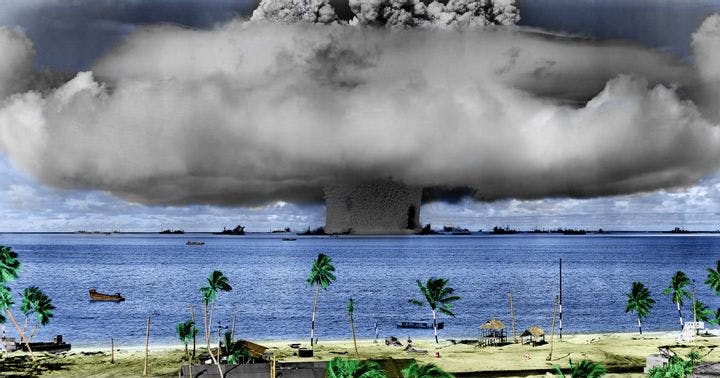Winter 2014
Save the Nukes!
– The Wilson Quarterly
America’s nuclear arsenal isn’t dangerous. Getting rid of it might be.
Now that the Cold War is over, it may be hard to see why the United States needs a large nuclear arsenal. It’s excessive; it’s provocative; it’s irresponsible; and it’s expensive, critics say — especially at a time when the country enjoys unparalleled conventional military superiority.
Disarmament is no longer an exclusively left-wing cause. In 2007, a bipartisan group of foreign-policy establishment figures, including former secretary of state Henry Kissinger, called for a push toward “a world free of nuclear weapons.” President Barack Obama has proposed reducing the U.S. nuclear arsenal to 1,000 warheads, the smallest number since 1953.
Bad idea, argues Matthew Kroenig, a political scientist at Georgetown University. Writing in Foreign Policy, he says that the illusion that nuclear weapons no longer matter has been fostered by the muting of great-power rivalry since the collapse of the Soviet Union. But other nations don’t see things that way: “Russia, China, India, Pakistan and North Korea are modernizing or expanding their nuclear arsenals, and Iran is vigorously pursuing its own nuclear capability,” Kroenig says. And China, which now has only an estimated 50 warheads capable of reaching the United States, looks likely to revive the great-power struggle.
Yale political scientist Paul Bracken argues that the world is on the verge of a “second nuclear age” and that nuclear weapons are re-emerging as “a vital element of statecraft and power politics.”
Some critics maintain that it would require only a small nuclear arsenal to deter these rising powers, but Kroenig’s research supports the opposite view. “In a statistical analysis of all nuclear-armed countries from 1945 to 2001 ... the state with more warheads was only one-third as likely to be challenged militarily by other countries and more than 10 times more likely to prevail in a crisis.”
History repeats this lesson. When the United States could demonstrate clear nuclear superiority over the Soviet Union, it enjoyed more favorable foreign-policy outcomes. Not only did Washington prevent Moscow from building submarine bases in Cuba, but in 1967 and again in 1973, Washington’s nuclear advantage kept Soviet forces from supporting Arab allies in their wars against Israel. However, in 1979, when the nuclear gap narrowed, the United States failed to roll back the Soviet invasion of Afghanistan.
Some strategists argue that a large arsenal is provocative, increasing the likelihood of a preemptive attack from another nuclear power. The Obama administration has embraced this view, identifying “strategic stability” as a goal and proposing a new agreement with Russia further reducing the current treaty limit of 1,550 warheads in 2017. Kroenig sees tortured logic behind the notion that arsenals are provocative: “After all, the United States possesses a first-strike advantage against the world’s 184 nonnuclear states, and it doesn’t wring its hands about that.” Why fret about nuclear superiority over Russia and China? Beijing might even regard any U.S. arms reduction less as a reassuring gesture than as a prime opportunity to catch up.
Still another argument for reducing the American nuclear arsenal is that in leading by example, Washington would promote global nonproliferation. Kroenig’s short answer: “Keep dreaming.” The United States has been cutting its nuclear forces since the 1960s, and there’s no evidence that these efforts have reduced worldwide proliferation. Indeed, Kroenig notes, the pathbreaking 1968 Treaty on the Non-Proliferation of Nuclear Weapons was ratified at a peak moment of U.S. nuclear capacity.
Shrinking the arsenal isn’t even cost effective, Kroenig contends. Most of the cost is in the infrastructure, not the weapons themselves, and nuclear programs make up only four percent of the U.S. defense budget. Demilitarizing bombs and weapon-building facilities would cost billions. It’s true that the United States could save approximately $3.9 billion annually by delaying the modernization of missiles and other delivery vehicles, but that’s “nothing short of trivial” compared to the $600 billion spent on defense each year. And the compelling rationale that fostered the U.S. nuclear buildup in the 1950s still applies today: Nuclear weapons are a much cheaper form of deterrence than conventional armies.
There is a simple principle at the bottom of Kroenig’s argument: “The more devastating that adversaries find the prospect of nuclear war, the less likely they will be to start trouble.” He thinks the Obama administration ought to abandon its talk of further reducing the nuclear weapons count and “follow through on its promise to fully modernize U.S. nuclear infrastructure.”
* * *
The Source: "Think Again: American Nuclear Disarmament," by Matthew Kroenig. Foreign Policy, September 2013.
Photo courtesy of the U.S. Library of Congress
